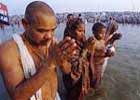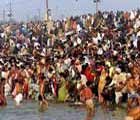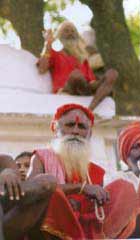Symbolically speaking, the forces of creation are collected in one vessel (Kumbh) and a celebration (mela) ensues, which is why this event is called 'Kumbh Mela'. "Kumbh" meaning the pot and "Mela" a sacred Hindu pilgrimage, attracts the world's largest congregation of religious pilgrims. The Kumbh Mela takes place in the Indian month of Magh - February/March. The major Kumbh Mela occurs once in 12 years. There are smaller and bigger Kumbh Mela’s. They are:
Magh Mela
The Annual Mini Kumbh is held every year except the years of Kumbh
Mela and Ardh Kumbh Mela. Magh Mela is held in the month of Magh;
hence the name. During this period, about two to three million
devotees throng this place.Kumbh Mela
The mela is held every three years, rotating through the four cities
of Prayag, Nasik, Haridwar and Ujjain.Ardh Kumbh Mela
Held in the 6th year after Kumbh Mela, i.e. it falls between two Kumbh
Melas. It has got the same religious value and attracts millions of
people. It has the same main bathing days as in Kumbh Mela.The Purna Kumbh Mela
The biggest and the most auspicious fair, which falls once every 12
years, is always held at Allahabad, for the 'Sangam' or the confluence
of rivers is considered to be exceptionally sacred. This Mela presents the surrealistic view of a mini-India, where trans-sectarian Hindus are one on the issue of the virtues of the holy bath. All the devotees experience and understand the invisible, ultimate reality of wholeness and oneness, in the same way as does a pilgrimage to Mecca to Muslims and Jerusalem to Christians of different quarters of the world.
Maha Kumbh Mela
This is an extraordinary, once-in-a-life-time Indian festival,
occurring every 144 years. Legend has it that Lord Vishnu saved the elixir (Amrut) from the demons and gave it to the vassal gods, called Devas, in a pot. The Devas rested the pot at each of the four cities of Allahabad, Haridwar, Ujjain, and Nasik. This is the reason why this festival is celebrated only at these four places.
Kumbh Mela is the greatest riverside religious festival of Hindus that takes place once every three years. It attracts millions of devotees and visitors from all backgrounds. Scores of ash-covered holy men and sage’s known as rishis and sadhus, in all shapes and sizes, flock to the centre of the Mela. The festival is rotated between four holy places of Hindus. The Sangam at Allahabad is the holiest as three rivers - Ganga, Yamuna and Saraswati converge there. Thousands of devotees take a holy dip in the river that is believed to purge them of their sin.
Millions of Hindu worshippers take a dip in the holy River Ganges at the confluence of the three rivers; the holy Ganges, Yamuna and the mythical Saraswati, to wash away their sins as part of a festival, in the small town of Allahabad. The month long Mela (festival) represents a time when the river is believed to turn into purifying nectar, allowing the devotees to cleanse their souls as they bathe.








